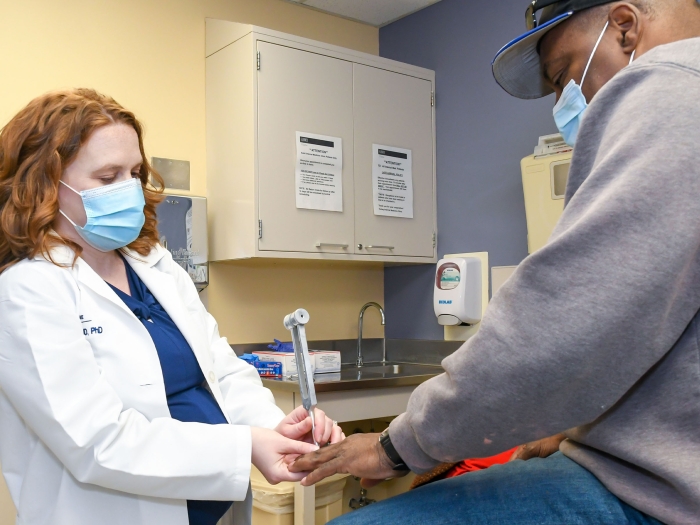ALS is a debilitating, progressive disease without a cure. Researchers now find pesticides and other environmental toxins could play a part in the disease’s onset.
10:59 AM
Author |

New research shows environmental pollutants could affect the chances a person will develop amyotrophic lateral sclerosis, or ALS.
There is no cure for this rapidly progressive motor neuron disease, also known as Lou Gehrig's disease. Those afflicted eventually lose their strength and ability to move their arms, legs and body.
As part of a larger study on environmental risk factors for ALS, University of Michigan researchers published their work on pesticide and other environmental exposures in JAMA Neurology.
"From the first ALS patient I saw over 25 years ago to the ALS patient I diagnosed this week, I am always asked the same question, 'Why me? What is different about my life that I got this disease?'" says co-senior author Eva Feldman, M.D., Ph.D., director of the A. Alfred Taubman Medical Research Institute and longtime ALS clinician and researcher. "I want to answer that question for my patients."
Feldman's team studied 156 people with ALS and 128 people without it. All described their exposure to pollutants at work and at home, with a focus on occupational exposure. The researchers also measured toxic persistent environmental pollutants in blood to gain a more comprehensive assessment of environmental exposures.
"We found these toxic chemicals in individuals both with and without ALS," says co-first author Stephen Goutman, M.D., director of the U-M Comprehensive ALS Clinic. "We are likely all exposed without our own knowledge, from the air, water and our diet, as these chemicals can last decades in the environment. However, persons with ALS, overall, had higher concentrations of these chemicals, especially in regards to pesticides."
There was no strong correlation, however, between any particular occupation and likelihood of developing ALS, except for service in the armed forces, a link found in previous studies.
Blood tests showed increased odds of ALS for those with exposure to several different types of chemicals, many of which are no longer widely used because of environmental concerns, such as the pesticide DDT. Some of the classes of chemicals studied, however, such as polybrominated diphenyl ethers, used as flame retardants, have only recently undergone scrutiny as potential health hazards.
"The challenge is that persons are likely exposed to multiple chemicals and therefore it is too soon for us to know whether individual chemicals, or mixtures of chemicals, lead to motor neuron damage," Goutman says. "Next, we will really dive into particular chemicals that could be risk factors for the disease."
It is time to understand how these exposures lead to disease with an eye to halting ALS onset.Eva Feldman, M.D., Ph.D.
'The first and very important step'
The researchers believe a better understanding of environmental risk factors for ALS could lead to an understanding of why persons develop ALS and also help to explain clusters of ALS cases in different geographical areas.
"This is the first and very important step to identifying what specific exposures are associated with ALS — to answering the 'why me?' question," Feldman says. "Now it is time to understand how these exposures lead to disease with an eye to halting ALS onset. As one of my patients said to me before he died, we want a world without ALS."
The Centers for Disease Control and Prevention/Agency for Toxic Substances and Disease Registry, the National Center for Research Resources and the National Center for Advancing Translational Sciences provided support for this research.
Disclosure: Feldman receives research support from the NIH (NINDK, NIDDK), CDC/ Agency for Toxic Substances and Disease Registry, and the A. Alfred Taubman Medical Research Institute. Goutman receives support from the CDC/Agency for Toxic Substances and Disease Registry and Neuralstem. Co-first author Feng-Chiao Su receives support from the CDC/Agency for Toxic Substances and Disease Registry, the Health Effects Institute and the U.S. Environmental Protection Agency. Co-author Sergey Chernyak receives support from the CDC/Agency for Toxic Substances and Disease Registry and the U-M Water Center. Co-author Bhramar Mukherjee receives support from the U.S. EPA, NIH, CDC/Agency for Toxic Substances and Disease Registry and the National Science Foundation. Co-author Brian Callaghan receives support from the A. Alfred Taubman Medical Research Institute, NIH and Impeto Medical Inc., and serves as a consultant for Advance Medical and for a grant for the Patient-Centered Outcomes Research Institute. Co-author Stuart Batterman receives support from the NIH/NIEHS, NIOS, CDC/Agency for Toxic Substances and Disease Registry, and the U.S. EPA and Health Effects Institute.

Explore a variety of healthcare news & stories by visiting the Health Lab home page for more articles.

Department of Communication at Michigan Medicine
Want top health & research news weekly? Sign up for Health Lab’s newsletters today!





